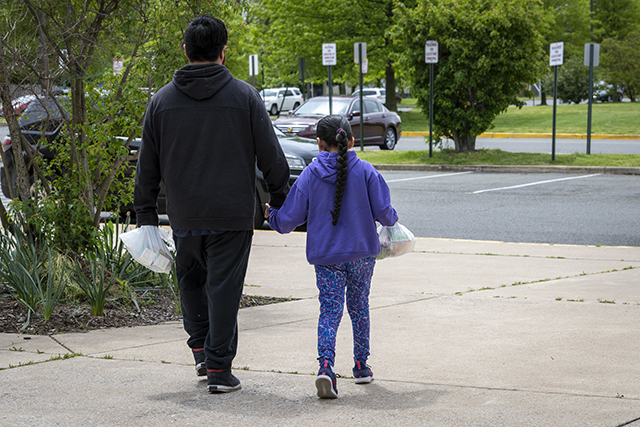Racial Disparities in Food Insecurity Persist
New data shows Black and Hispanic households with children much more likely to experience food hardships
Get all our news

A middle school in Arlington, Virginia provides families with meals during COVID-19, particularly for those eligible for free- or reduced-priced meals.
During the COVID-19 crisis, food insecurity rates among households with children have been sharply elevated—particularly so among Black and Hispanic respondents. In this report, we describe levels and trends in food insecurity among households with children by the race/ethnicity of the adult respondent for the household.
We find that food insecurity rates and related measures of food hardship are elevated for all groups, and there is some evidence they have improved in recent weeks among White households. We also explore additional household economic measures and find that substantial shares—especially among Blacks and Hispanics—are worried about their incomes and ability to afford the goods they need over the next four weeks. Together, these indicators paint a picture of substantial and disparate economic hardship during the COVID-19 era.
As described in our prior work, the Census Household Pulse Survey (CHHPS) collects information on food sufficiency over the past 7 days. To estimate food security from these data, we use the relationship between food sufficiency and food security from the Current Population Survey Food Security Supplement (CPS-FSS) calculated over 2015–18 for the same group. The results are qualitatively similar if we analyze food sufficiency instead of food security.
Disparities in food insecurity across racial and ethnic groups are large. Across the eight weeks for which CHHPS microdata are available, covering April 23–June 23, 41.1% of Black respondents’ households have experienced food insecurity in the prior week, as have 36.9% of Hispanic respondents’ households and 23.2% of White respondents’ households. Across weeks, as shown in Figure 1, rates of food insecurity declined statistically from week 2 (May 7–12) to week 8 (June 18–23) among Whites but have remained statistically unchanged among Blacks and Hispanics.
Additionally, key findings of the report show:
- During the COVID-19 crisis, rates of food insecurity among Black households with children are nearly twice as high as they are among White households with children in the CHHPS. Rates for Hispanic respondents are 60% higher than they are among Whites. These ratios are similar to their historical patterns in the CPS-FSS, which for over 20 years has collected annual data on food insecurity experienced over the past year.
- For rates averaged across April–June 2020 from the CHHPS, estimates of food insecurity doubled for White and Hispanic households and increased by 60% for Black households.
- We find that the share of those households reporting “sometimes” or “often” not enough to eat during the last week in the CHHPS has more than tripled for White and Hispanic households, and more than doubled for Black households.
- While the percentage of households with children reporting not enough to eat has remained statistically unchanged between week 2 (May 7–May 12) and week 8 (June 18–23) of the CHHPS for White and Hispanic households, the percentage of Black households reporting not enough to eat decreased from 26.3% to 21.6%.
- In comparing data from the COVID Impact Survey to a similarly worded question from the National Health Interview Survey from 2018, we find the increase in food hardship between 2018 and April 2020 measured in the COVID Impact Survey is larger for each group than it is in the CHHPS, but the disparities across racial and ethnic groups are smaller.
- Consistent with the disparities in food insecurity observed, a series of additional economic indicators that can be calculated from the CHHPS for unemployment, making next month’s mortgage/rent payment, or buying all of the food they need in the next month show worse conditions among Black and Hispanic households, and in many cases seem to be part of a worsening trend.
Data collected during the COVID-19 crisis indicate that rates of food insecurity and other measures of food hardship in households with children are dramatically elevated compared with pre-COVID levels. In addition, Black and Hispanic households with children are much more likely to experience food hardships than are White households with children. Other measures, including current employment status, as well as expectations about future income losses and the ability to afford necessities, also show important disparities across racial and ethnic groups. As others have argued, these patterns indicate the need for continued relief payments until the economy rebounds, such as increased SNAP and Unemployment Insurance payments.
The Census Household Pulse Survey has been providing timely information on a range of measures during the COVID-19 crisis. Unfortunately, it is scheduled to cease releasing new data in the coming weeks. To continue to monitor real-time impacts of COVID-19 and devise appropriate policy solutions, we encourage Congress to authorize an extension of the data collection.
Diane Whitmore Schanzenbach is the Margaret Walker Alexander Professor and IPR Director. Abigail Pitts is a research analyst. USDA photo by Tom Witham, taken on May 2, 2020. Read the full report here.
Published: July 9, 2020.


